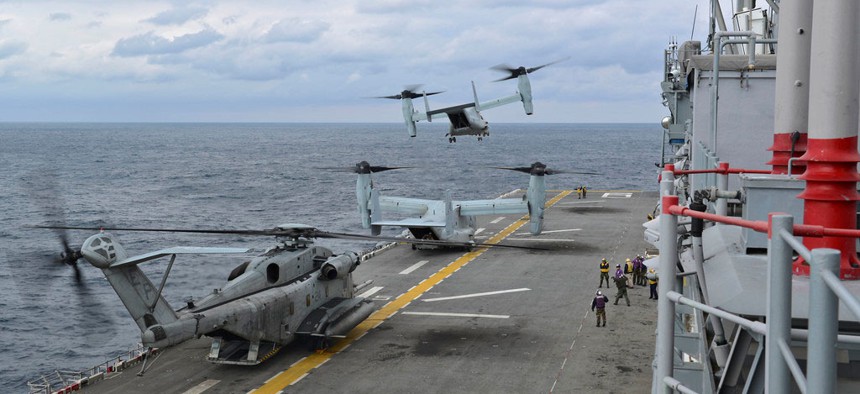
A group of MV-22 Ospreys taking off from the USS Bonhomme Richard during operations in the East China Sea U.S. Navy
What Hawks and Doves Both Miss on the Asia Pivot
Depending on one's perspective, China is either unchecked or overly provoked. But there is a bigger point still missing from most debates. by Janine Davidson
President Obama’s long awaited trip to Asia has highlighted the ongoing debate about the military part of the “rebalance.” Criticism comes from all sides. Those who claim the Obama administration has not matched its verbal commitment to the region with real action or military investment are countered by others who worry that the policy is overly militaristic and provocative. Depending on the perspective, China is either going unchecked or being provoked, both of which would lead to instability if not corrected.
But this China-centric debate misses the bigger point about the role America plays in the region and the way that role is changing. The network of alliances and partnerships the U.S. has developed with over a dozen countries throughout the region represents the foundation of America’s Asia-Pacific policy – and is our most important asset. It is sustained multilateral engagement focused on promoting cooperative approaches to stability and security among these allies and partners, not swelling U.S. force deployments aimed at preparing for war against China, that will be the real benchmark of success for the rebalance.
Contrary to common misperception the rebalance was never designed as a zero-sum “pivot” from Europe or the Middle East to Asia. Rather it was meant to rebalance attention and resources back to Asia after a decade of large-scale counterinsurgency operations in Iraq and Afghanistan. For instance, throughout the last decade, Marines normally postured in Okinawa, Japan were nearly perpetually deployed from the region to support operations in the Middle East. Air assets in the region and army units based in Korea were periodically pulled from their forward stationed bases to support the two wars.
Although, as I have previously written, the non-military elements of the rebalance to Asia are predominant, the military shifts are not insignificant. In terms of physical changes to U.S. military presence across the region, what the U.S. has decided to keep in Asia is as important as what it decided to add. Many forget that the Bush administration had initiated a downsizing of the U.S. military presence in Korea, which in turn understandably fueled concern about America’s commitment. Therefore, one of the first steps of the rebalance was to halt that repositioning and to announce the U.S. would sustain a robust presence in both Korea and Japan (28,500 and 50,000 military respectively).
Next, recognizing that the U.S. military presence was heavily weighted in the northeast, the rebalance called for increased presence and engagement with countries to the south, such as Australia, Singapore, Thailand, and the Philippines. Up to 2,500 Marines will conduct regular six-month deployments to Darwin, Australia for exercises with Australian and other regional forces; while two new littoral combat ships will stage out of Singapore to conduct exercises with various Southeast Asian militaries. Other moves include the Navy’s posturing of 60 percent of its fleet in the region and new access and cooperation agreements with the Philippines, Thailand, and Vietnam.
Meanwhile, the President’s visit to Japan underscores the increased military assets the U.S. has recently committed, including increased global hawk rotations to monitor the contested areas around the Senkaku islands, a second missile defense early warning radar and the forward-deployment of two more AEGIS ballistic missile defense ships focused on the threat from North Korea.
Contrary to popular critiques, this military presence is neither provocatively aimed at China nor insignificantly robust. Nor is it unsustainable. Sure, the U.S. is downsizing. But even with the cuts being taken, the U.S. military’s base (non-war) budget is still $136 billion more in 2015 dollars than in 2001. This is more than a reasonable level of investment to sustain America’s commitment to the Asia-Pacific.
This post appears courtesy of CFR.org.
NEXT STORY: U.S.-Russian Cultural Relations Are on Ice, Too




